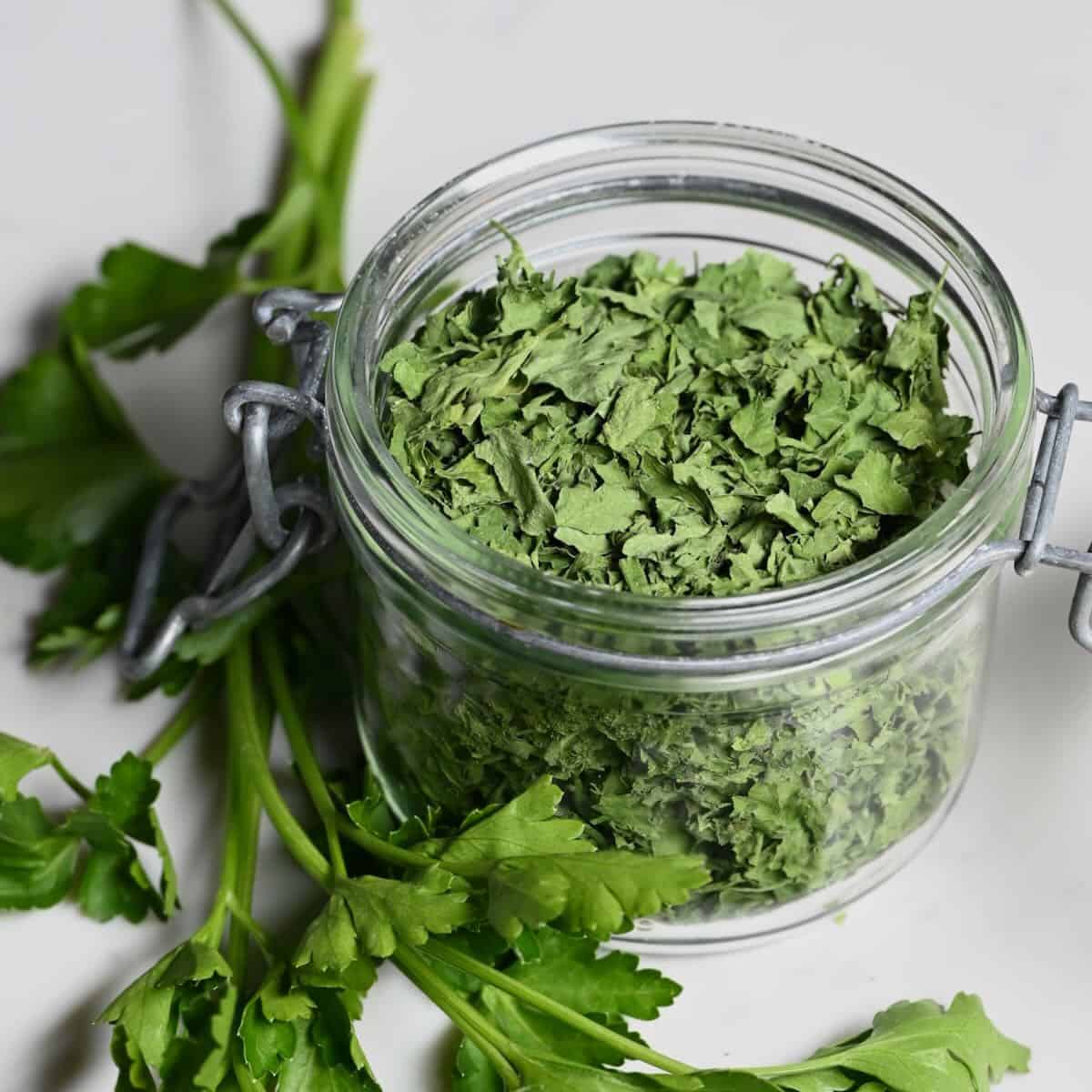Drying parsley may sound like a simple task, but mastering the art of preserving its vibrant flavor is an art form in itself.
Forget about the disappointing store-bought versions and venture into the world of home-dried parsley, where the possibilities are endless.
With a plethora of methods at your disposal, from low-temperature dehydrators to unconventional tactics like hanging or even utilizing your car windshield, you’ll soon be curating your own herb haven.
But beware, for there are secrets to this ancient culinary practice that may alter the way you approach cooking forever.
So, gather your knowledge and your parsley, for we are about to embark on a journey into the magical realm of dried herbs.
how to dry parsley
To dry parsley, there are several methods you can use.
The preferred method is to use a dehydrator, keeping the temperature around 95 degrees Fahrenheit to preserve the flavor.
Alternatively, you can hang the parsley upside down in a cool, dark place with air movement using a fan, or lay it in a single layer on a window screen in a hot car.
It is important for the parsley to be completely dry and brittle before storing it in an airtight container away from light and heat.
Dried parsley should be used in half the amount of fresh parsley in recipes due to its concentrated flavor.
Key Points:
- Dehydrator is the preferred method to dry parsley
- Hang the parsley upside down in a cool, dark place
- Lay parsley in a single layer on a window screen in a hot car
- Make sure parsley is completely dry and brittle before storing
- Store dried parsley in an airtight container away from light and heat
- Use half the amount of dried parsley compared to fresh parsley in recipes
how to dry parsley – Watch Video
💡
Pro Tips:
1. The practice of drying parsley actually dates back to ancient Rome, where it was commonly used both as a culinary herb and as a decorative garnish.
2. Did you know that parsley can be successfully dried through air drying, oven drying, or using a food dehydrator? Each method offers slightly different results in terms of color, flavor, and texture.
3. While parsley leaves are typically the most commonly used parts, parsley stems can also be air-dried and used in cooking. They possess a similar flavor profile and can add a delightful crunch to dishes.
4. If you’re drying parsley at home, one pro tip is to harvest the leaves and stems in the morning when the essential oils are at their peak. This will ensure maximum flavor retention during the drying process.
5. Parsley is a versatile herb with numerous health benefits. Apart from being a great source of vitamins A, C, and K, it also contains flavonoids that act as antioxidants and may help support heart health. So not only does drying parsley preserve its flavor, but it also allows you to enjoy its nutritional benefits year-round.
Preserving Flavor: Home Drying Vs Store-Bought
The flavor of dried herbs can vary greatly depending on the method of drying. Store-bought dried parsley often lacks the vibrant flavor of fresh parsley. On the other hand, drying parsley at home allows for better preservation of its natural flavors and essential oils. By taking control of the drying process, you can ensure that your dried parsley retains its distinct taste.
Low Temperatures For Better Results
When drying parsley, it is essential to keep the temperatures low, around 95 degrees Fahrenheit. High heat can cause the oils in the parsley to evaporate, resulting in a loss of flavor. By using low temperatures, you can preserve the aromatic oils that give parsley its unique taste. This careful approach allows the parsley to dry slowly and evenly, ensuring that its flavors are locked in.
- Keep temperatures low, around 95 degrees Fahrenheit
- High heat can cause flavor loss by evaporating oils
- Low temperatures preserve aromatic oils
- Slow and even drying locks in flavors
“By using low temperatures, you can preserve the aromatic oils that give parsley its unique taste.”
Dehydrator: The Preferred Method
The most preferred method for drying parsley is using a dehydrator. A dehydrator provides optimal airflow and temperature control, making it an ideal tool for preserving herbs. To dry parsley in a dehydrator, follow these steps:
- Choose healthy leaves with a few inches of stem
- Wash the parsley and pat the leaves dry on a towel
- Spread the parsley out on the trays of the dehydrator
- Set the temperature to around 95 degrees Fahrenheit
- Allow the parsley to dry for a few hours with a good dehydrator
- Once the parsley is completely dry and brittle, remove it from the dehydrator
- Store it in an airtight container.
Note: Using a dehydrator is the most effective way to dry parsley as it ensures optimal airflow and temperature control.
Hanging Parsley In A Cool, Dark Place
An alternative method for drying parsley involves hanging it upside down in a cool, dark place with air movement. This method is especially useful if you do not have a dehydrator at hand. To dry parsley using this technique, gather the parsley into small bundles, tie them at the stems, and hang them upside down. A garage or a pantry with good air circulation is ideal. You can even use a fan to enhance the airflow around the herbs. Leave the parsley to dry for a week or longer until the leaves become completely dry and brittle.
Drying On A Window Screen Or Baking Rack
If you want to dry parsley using a simple method, using a window screen or baking rack can be effective. Lay the parsley in a single layer on the screen or rack and place it in a location that receives ample sunlight and warm air, like a car windshield on a sunny day. The heat from the sun will gradually dry the parsley. However, it’s important to monitor the drying process to ensure the herbs do not get too hot or become over-dried.
- Use a window screen or baking rack for drying parsley.
- Lay parsley in a single layer.
- Choose a location with ample sunlight and warm air.
- Monitor the drying process to avoid overheating or over-drying.
“The heat from the sun will gradually dry the parsley.”
Oven Drying: Cautious Approach Needed
While oven drying is a possibility, caution must be exercised. Most ovens cannot maintain low temperatures as required for drying parsley. However, if your oven can be set at a low temperature without burning the herbs or evaporating their oils, it can be used as an alternative method. Spread the parsley in a single layer on a baking sheet and place it in the oven. Keep the oven door slightly ajar to allow moisture to escape. Check the parsley frequently to ensure it does not over-dry, as ovens can have uneven heat distribution.
Step-By-Step Process For Drying Parsley
Drying parsley at home is a simple process that requires a few steps. Begin by selecting healthy parsley leaves with a few inches of stem. Wash the parsley thoroughly and pat the leaves dry on a towel. If needed, allow the parsley to air dry to remove any excess moisture. Next, decide on your preferred drying method, such as using a dehydrator, hanging the parsley, drying on a window screen, or using an oven. Follow the specific instructions for your chosen method, ensuring that the parsley is spread out or hung in a well-ventilated area. The drying process can take a few hours to a week, depending on the chosen method and drying conditions. It is vital to ensure that the parsley is completely dry and brittle before removing it from the drying apparatus.
Storing Dried Herbs For Long-Lasting Freshness
Proper storage is crucial to maintain the freshness and flavor of dried herbs, including parsley. After the parsley is thoroughly dried, store it in an airtight container to prevent moisture and air from entering. Glass jars are preferable over plastic containers, as they provide a more airtight seal. Additionally, it’s important to keep the dried herbs away from light and heat. Exposure to light can cause the herbs to lose their flavor, while heat can break down the oils within the herbs. If stored correctly, dried herbs can last at least a year without going bad, although their flavor may diminish over time.
Adjusting Dried Herb Quantities In Recipes
When using dried herbs in recipes, it is important to adjust the quantity compared to fresh herbs. Dried herbs have a more concentrated flavor, so only half the amount of dried herbs is typically needed compared to the amount of fresh herbs stated in a recipe. It is advisable to start with a smaller amount and adjust to taste.
- Adjust the quantity of dried herbs compared to fresh herbs
- Use only half the amount of dried herbs
- Start with a smaller amount and adjust to taste.
Fresh Vs Dried Herbs In Saucy Dishes: Freezing For Better Results
While dried parsley works well in many dishes, some sauces or condiments heavily rely on the freshness of herbs. For recipes like pesto or chimichurri sauces, it is recommended to use fresh herbs for optimal results. If you have an abundance of fresh parsley, consider making the sauce and freezing it for future use. By doing so, you can enjoy the vibrant flavors of fresh herbs without compromising the integrity of the dish.
In conclusion, drying parsley at home allows for better preservation of its flavor compared to store-bought dried parsley. By utilizing low drying temperatures and different methods such as using a dehydrator, hanging parsley, drying on a window screen, or cautious oven drying, one can achieve perfectly dried parsley. When storing dried herbs, ensure they are kept in airtight containers away from light and heat. Adjusting the quantities of dried herbs in recipes is also important due to their concentrated flavor. While dried parsley can be used in various dishes, sauces heavily reliant on fresh herbs may not be best suited for dried parsley. In such cases, it is recommended to make the sauce with fresh herbs and freeze it for later use.
- Freezing fresh herb sauces for future use preserves their flavor.
- Use different drying methods, such as a dehydrator, hanging or drying on a window screen, or cautious oven drying to achieve optimal results.
- Store dried herbs in airtight containers away from light and heat.
- Adjust the quantities of dried herbs in recipes due to their concentrated flavor.
- Sauces heavily reliant on fresh herbs may not be best suited for dried parsley. Consider using fresh herbs and freezing the sauce.
💡
You may need to know these questions about how to dry parsley
What is the best way to dry fresh parsley?
To dry fresh parsley, it is essential to start with clean parsley leaves. Once they are washed and dried, preheat the oven to 170 degrees Fahrenheit. Spread the parsley on a baking or cookie sheet and place it in the oven for approximately 20 minutes. Afterward, gently crumble the dried parsley with your hands and store it in an airtight container for future use. This method ensures that the parsley is properly dried and will retain its flavor and aroma when stored.
Is it better to dry or freeze parsley?
While drying parsley can certainly be a convenient way to preserve its flavor, freezing it may offer some advantages. Freezing parsley helps retain its freshness and color for a longer period, allowing you to enjoy the herb’s vibrant taste even during the winter months. Additionally, freezing parsley is a straightforward process that requires minimal effort, making it a convenient option for preserving this versatile herb. So, if you’re looking for a simple and effective method to keep your parsley flavorsome, freezing might be the better choice for you.
How do you preserve parsley?
To preserve parsley, start by cleaning and drying the herb thoroughly. Once it’s ready, place the parsley in a large freezer bag and press it down to the bottom. The idea is to create a compact log or cigar shape. As you roll the log, make sure to remove as much air as possible from the bag. Seal it tightly and place it in the freezer, where it can be kept and used for later culinary adventures.
How long does dehydrated parsley last?
Dehydrated parsley, when stored correctly in an airtight container within a cool dark cabinet, can maintain its quality for around 2 to 3 years. However, for an even longer shelf life, vacuum sealing the dried parsley can extend its usability for many more years. It is essential to ensure proper storage to preserve the flavor and freshness of the dehydrated parsley.
Reference source
https://feastandfarm.com/how-to-dry-parsley/
https://mortadellahead.com/how-to-dry-parsley-in-the-oven/
https://news.okstate.edu/articles/agriculture/2020/gedon_freezing_fresh_herbs.html
https://urbanfarmandkitchen.com/how-to-preserve-parsley-for-long-term-storage/



